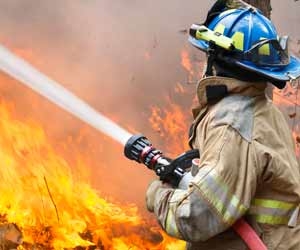Fighting Wildfires with the Forest Service
(The following is reprinted courtesy of the U.S. Forest Service.)
Putting out wildfires has always been a vital part of Forest Service work. Over the years we’ve developed better ways to do that: helicopters and airplanes ring crews and smokejumpers to remote locations, air tankers drop fire retardant, and radio and telephone systems form the sophisticated communication network necessary to coordinate these efforts.

The Forest Service today maintains the largest wildfire suppression system in the world.
Fires must be suppressed safely and economically. We have to understand how a fire will behave under many different circumstances. Using a basic knowledge of the area and predicted weather conditions, we plan the attack on the fire. This becomes the strategy underlying all our actions.
A fire’s burning edge is treated by wetting, cooling, smothering, or chemically quenching it; or by separating the burning material from the unburned. It may be approached indirectly, using a fireline cleared to bare earth. This fireline is located just far enough away from the fire’s edge so the crews can work safely. We might also use natural barriers, such as a stream and rock; or we might set a backfire, to stop a wildfire in its tracks.
The Forest Service is always prepared for this task. Fire crews are chosen, trained, and equipped. Dispatch centers stand ready to keep in constant touch with the crews. Airplanes and helicopters can take off on short notice. Plows, bulldozers, and water tankers are available.
The task is complicated because the terrain, altitude, and scarcity of roads can make it hard to get crews and supplies to the spot where they can do the most good.
Most fires in the Pacific Northwest are suppressed quickly. The few that aren’t are called escaped fires. However, these fires (5 percent) account for about 95 percent of the resource damage and suppression costs.
When a fire escapes the first attack, a new plan is set in motion rapidly and revised continually. The fire manager can use many new technologies, such as fire-retardant chemicals, infrared mapping devices, and computerized weather forecasting systems. The fire manager is a skilled professional who knows how to use these systems effectively.
To make sure we make the best use of all resources, we share crews, equipment, and expertise with many federal, state, and local government agencies. This helps to better utilize our suppression resources.

